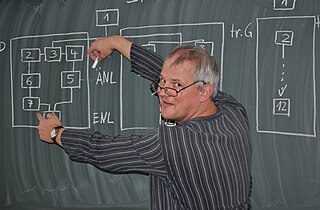Nazi archaeology was the movement led by various Nazi leaders, such as Adolf Hitler and Heinrich Himmler, archaeologists and other scholars to research the German past in order to strengthen nationalism.
Bolko von Richthofen was a German archaeologist and a distant relative of the family of Manfred von Richthofen, the "Red Baron". He is sometimes confused with his distant cousin and namesake, Karl Bolko von Richthofen (1903–1971) – the youngest brother of the fighter ace.

Carl Schuchhardt was a German archaeologist and museum director. For many years, he was the director of the pre-historic department of the Ethnological Museum of Berlin. He was involved in numerous excavations, both in Europe and the Middle East, and contributed significantly to archaeological science. In his time, he was seen as Germany's most senior and accomplished prehistorian.

The Museum für Vor- und Frühgeschichte, part of the Berlin State Museums, is one of major archaeological museums of Germany, and among the largest supra-regional collections of prehistoric finds in Europe. It was previously located in the former theatre building by Carl Ferdinand Langhans, next to Schloss Charlottenburg, and encompasses six exhibition halls on three floors. Since October 2009, the museum's exhibitions are now displayed in the Neues Museum on Museum Island.

Hans-Georg Stephan is a German university professor specializing in European medieval archaeology and post-medieval archaeology.

The Bavarian State Archaeological Collection in Munich is the central museum of prehistory of the State of Bavaria, considered to be one of the most important archaeological collections and cultural history museums in Germany.
Joachim Werner was a German archaeologist who was especially concerned with the archaeology of the Early Middle Ages in Germany. The majority of German professorships with particular focus on the field of the Early Middle Ages were in the second half of the 20th century occupied by his academic pupils.

Herbert Jankuhn was a German archaeologist who specialized in the archaeology of Germanic peoples. He is best known for his excavations at the Viking Age site of Hedeby, and for his instrumental role in the publishing of the second edition of the Reallexikon der Germanischen Altertumskunde.

The Römisch-Germanisches Zentralmuseum (RGZM), Leibniz Research Institute for Archaeology, is headquartered in Mainz. It is supported by the Federal Republic of Germany and its states and is a member of the Leibniz Association of German research institutions.
The Deutsche Gesellschaft für Ur- und Frühgeschichte e.V. (DGUF) – the German Society for Pre- and Protohistory – has more than 700 members and is thus the largest German association active in the field of prehistory and the early historical period. Its members are not only archaeology professionals but also private citizens interested in the subject. Known informally by its acronym, DGUF, it is the only nationwide archaeological association that also allows individual personal membership.
Ernst Sprockhoff was a German prehistorian and inventor of the Sprockhoff numbering system for megalithic monuments in Germany.
Sabine Gaudzinski-Windheuser is a German archaeologist. She is a Professor at the Johannes Gutenberg-University, Mainz and Director of the Monrepos Archaeological Research Centre and Museum for human behavioural Evolution of the Römisch-Germanisches Zentralmuseum at Monrepos Castle in Neuwied, Germany.
Rolf Hachmann was a German archaeologist who specialized in pre- and protohistory.
Horst Wolfgang Böhme is a German archaeologist with a focus on Late Antiquity / Early Middle Ages and research into castles.
Paul Grimm was a German prehistorian and also a pioneer of Medieval archaeology, especially of the excavation of abandoned villages and castles. Grimm worked on various periods, but mainly in central Germany – the names of two important Neolithic archaeological cultures in the area, the Baalberge group and the Salzmünde group derive from him. His comprehensive excavations in Hohenrode and Tilleda are important milestones in the history of German archaeology.
Heiko Steuer is a German archaeologist, notable for his research into social and economic history in early Europe. He serves as co-editor of Germanische Altertumskunde Online.

Raiko Krauss, born 1973 in Friedrichshain, Berlin is a German archaeologist of prehistory.
Jürgen Oldenstein is a German provincial Roman archaeologist.
Benjamin Sigmund Oehrl is a German archaeologist and philologist who specializes in Germanic studies.
Gilbert Trathnigg was an Austrian archaeologist and philologist who specialized in Germanic studies.






